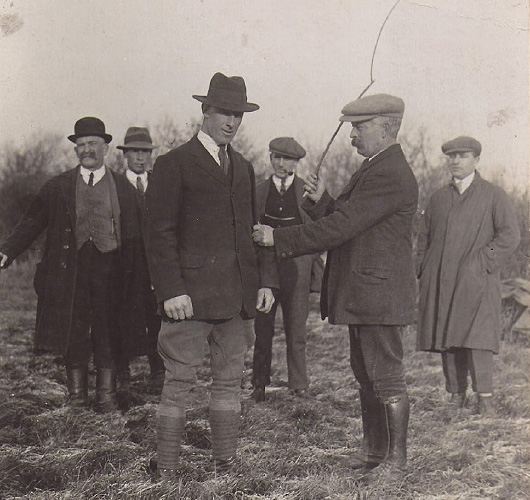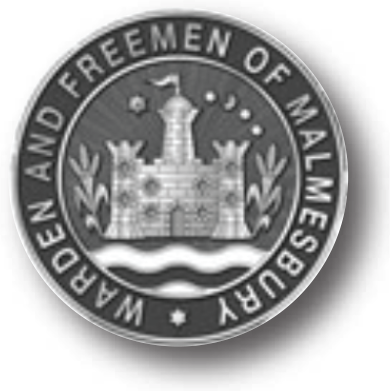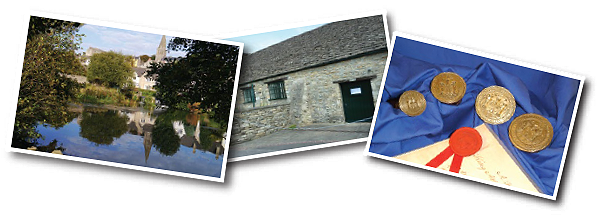Turf and Twig Ceremony

This photograph was taken on January, 1922 on Foxley Common, a part of King’s Heath more widely known in those days as Malmesbury Common. The ceremony is taking place near the public house called the Royal Oak, known to Commoners as the “Slappy”.
The practice at this time was to initiate new Commoners, after they had been accepted, at Court. A shallow hole would be dug in the turf into which the new Commoner would place a silver coin. The following words would then be recited by the person carrying out the ceremony: “Turf and Twig I give to thee. As King Athelstan gave to me. A good brother thou shalt be.” The initiator would then strike the new Commoner (Ernest Goodfield) across the back with a twig three times, remove the silver from the hole and make tracks for the Slappy with all the other participants in the ceremony.
Besides causing great economic and social disruption in the town, the dissolution removed the local authority of jurisdiction and administration in the immediate area. Also the guild system was now in permanent decline so it is not surprising that much confusion in the towns’ affairs arose during the reign of Queen Elizabeth I. Apparently, the town suffered considerable decay, but in 1566 a group of the more prominent burgesses obtained the ‘fee farm’ of the town from the Queen, presumably with the hope that this would help to restore the former fortunes of the borough. By 1600 the burgesses had lost this but had acquired, by gift or purchase, other property in the town including St. John’s Hospital and it’s environs, and which, as the ‘Old Corporation’, they still own. This small group of burgesses became something like a self perpetuating oligarchy in the town, but not without many disputes with the generality of the burgesses, whose principal privilege remained that of being allowed to depasture a number of animals on King’s Heath.
In 1609 a final settlement was reached in the High Court of Chancery which, in most respects, fixed the organisation of the townsmen until modern times. The privileged group of burgesses and landholders were now officially created and the relationships between the various grades of burgess and their privileges as described in the opening paragraphs of this history, determined. It was at this time that the lowest level in the hierarchy was given the title of commoner. The Alderman, who had continued through all the disputes of the previous years as principal townsman, was now to be selected from amongst the capital burgesses. In return for their enhanced status, the capital burgesses were obliged to maintain a free school and almshouses for the benefit of the townspeople.

The seventeenth century was truly a century of constitutional change for the townspeople of Malmesbury and for the country at large. After the Chancery Decree of 1609 there were three Royal Charters, which between them settle the incorporation of the borough and its constitution until the great municipal reforming acts of the Victorian era. The first was granted in 1635, after an inquisition by King Charles I into the authority by which the borough held it’s properties and privileges. This charter formally recognised the Corporation of Alderman, Capital Burgesses and Assistant Burgesses as the government of the town and added a High Steward, who was to be a man ‘learned in the law’ and charged with advising the Corporation in its affairs. The High Steward need not be a commoner and in fact, never was until recent times. The Alderman (and from 1696 the High Steward too) was justice of the Peace and officiated at the Borough Sessions Court, where justice for petty crime within the borough was dispensed and certain administrative functions carried out. The Alderman was also the local Coroner and Clerk of the Market.
The second charter, that of King James II in 1685, was an attempt to obtain greater royal control over the affairs of the borough. It gave the king the power to dismiss capital burgesses he did not approve of. It did not last for long. The Glorious Revolution of 1688 brought in new rulers, the previous corporation was restored and affairs in Malmesbury returned to the old ways. Matters were finally settled by the Charter of 1696 which reaffirmed the provisions of the 1635 Charter. Constitutionally the Corporation now remained unchanged until municipal reform came to Malmesbury in 1886.



